Addis, Gondar & the Simean Highlands
January 13th – 23rd 2005
Duration: 11 days, 10 nights
Location: Ethiopia, Africa
Budget: €2500
Miles Travelled: 2,200
So this trip saw the team searching for the Ark of the Covenant -and rumour had it that it was supposedly in Axum at a festival called “Timkat”.
The trip starts will a flight to Addis via London and Alexandria in Egypt. A long first day of travelling to get to our destination. From Addis we head to Lake Tana, Bahar Dar, Gondar and Lalibela.
Following on from this we join in the festival of timkat in Axum before going to the Simean Highlands to looks for the Gelada Baboons. Then it is back to Addis and return home to Ireland.
Day One: January 13th – Irleand/Addis
Early start… got up at 5:30am – now I know that I am going on another epic trip. The taxi got to my place at 6 and we got to Derek’s around a quarter past. He was ready with the camera and recording as I was somehow drafted in to carrying his 100 litre rucksack and dumping it unceremoniously into the back of the taxi. Arrived at the airport for half 6 and paid the taxi man. We checked in and checked our bags through to Addis and got on the flight. Arrived in London at 09:10 and the connecting flight was 13:10. We went to Garfunkels restaurant and got some breakfast there while decided where we were going to go whilst waiting for the flight details to be posted. Mike – the third member of the team – was flying in from Dublin so we were waiting for him before proceeding on to Addis. The flights to Addis was delayed till 16.15 with no reasons given and no gates posted. Mike arrived shortly before 11 and we sat down and chatted for a bit. We had some good magazines to read courtesy of W.H. Smiths in the duty free. We got something to eat around 13:00 hours as we had brought some packed lunches with us. The gates was posted shortly after that and we proceeded down to our gate and awaited boarding. Unfortunately the plane was delayed another hour before taking off so we finally got air borne around 17:15 that day – 4 hours after the originally stated time on the tickets. Thankfully we are patient men and the waiting around was not that bad. The flight to Alexandria (our one stop over location) was approximately 5 hours. We got some food on the plane as well a movie – Without a Paddle. We arrived in Alexandria at local time of 00:15 on Friday morning. We sat in the plane for 45 minutes while the new guests came on and the plane was refuelled and then flew on the Addis. The flight time was approximately 4 hours to get to Addis and we landed around a quarter past 5 in the morning – local time.
Day Two: January 14th – Addis/ Bahar Dar
After flying all night literally, we had to run to get a VISA to enter the country. The cost of the VISA was 20 USD that you pay upon entrance and exiting the country. After getting the VISA we were met by our local guide in Addis, Frank. He rushed us to the check in desk so that we could get our connecting local flight to Bahir Dar at 07:00. Time was running out. We just made the flight and also had to pay 30 bir – 10 bir a head – for airport taxes. This is a tax that exists on internal flights only. We did not have any local currency on us but our guide was good enough to front us the money.
A 55 minute morning flight takes you to Bahir Dar, an attractive town with tree-lined avenues and the deep blue lake in the background. We arrived in Bahir Dar at 08:30 and were collected from the airport but a local. Transfer to the hotel was approximately 30 minutes as the roads were not that good there albeit only being less than 30 km away. The hotel – the Ghion – was located on the shores on Lake Tana. Lake Tana is Ethiopia’s largest lake and is dotted with islands. Many of these islands are the sites of churches and monasteries.
After checking in and meeting the owner of the hotel, a man named Bizrat, we proceeded across to the bank and changed some of our American dollars. The exchanges rate was 8.256 bir to 1 USD. Exchanging money in the bank was straight forward and the receipt that you are given is required at the end if you wish to change anything bir back to USD upon exiting the country. You can also pay your export tax is bir. After lunch, we took an excursion to the Blue Nile Falls (Tisisat Falls) with a private mini bus, about 30 km from Bahir Dar. The river Nile, over 800 km in length within Ethiopia and the longest river in Africa, holds part of its heart in Ethiopia. From Lake Tana, the Blue Nile, known locally as Abbay, flows to meet the white Nile in Khartoum, to form the great river that gives life to Egypt and the Sudan. It has been said that the Blue Nile contributes up to 80% of the Nile’s flow. Nowhere, is it more spectacular than where it thunders over the Tisisat Falls, literally “Smoking Water” – near Bahar Dar. Here millions of gallons of water cascade over the cliff face and into a gorge, creating spectacular rainbows, in one of the most awe-inspiring displays in Africa. They are Africa’s second largest waterfalls. No longer as spectacular as they once were due to the hydroelectric power plant filtering power from the once great river, the area in around the falls are scenic and abundant with endemic wildlife. We saw some baboons near an old 16th century Portuguese bridge, kingfisher birds hunting for food near the falls and a local bird called a francallin. Over night at the Ghion hotel on the shore of Lake Tana.
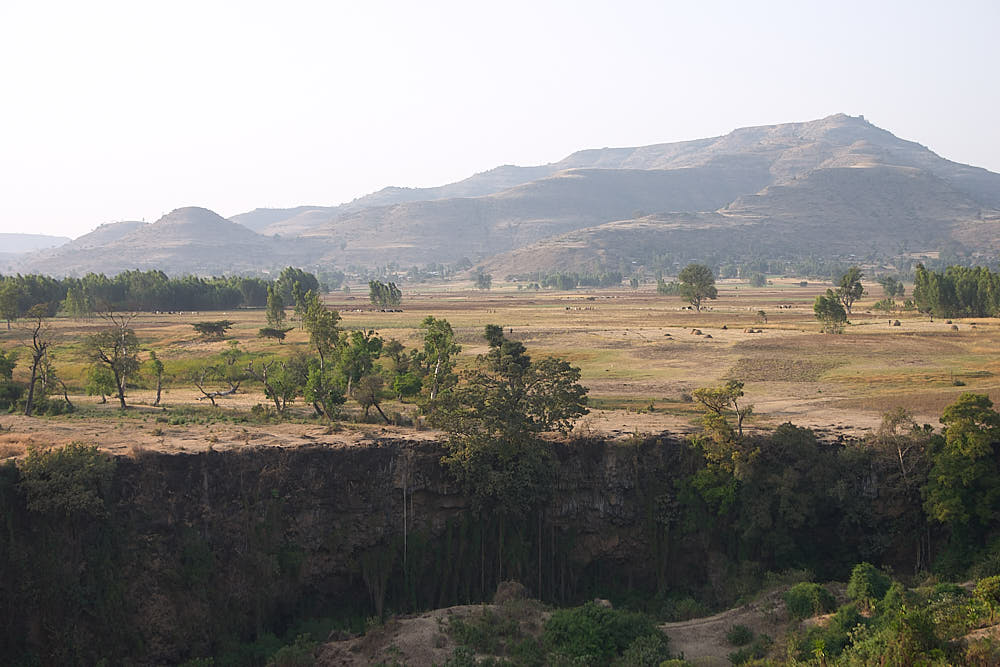
Day Three: January 15th – Lake Tana/Monasteries
We got up around 07:00 to get some breakfast before head out on the beautiful lake Tana. Lake Tana, the largest lake in Ethiopia, is the source of the famed Blue Nile. From here, the river starts its long journey to Khartoum, and on to the Mediterranean.
The 37 islands that are scattered about the surface of the lake shelter fascinating churches and monasteries, some of which have histories dating back to the 13th Century. It should be noted that most of the religious houses are not open to women. The most interesting islands are: Birgida Mariam, Dega Estefanous, Dek, Narga, Tana Cherkos, Mitsele Fasiledes, Kebran and Debre Maryam.
Kebran Gabriel is the principal monastery visited by male tourists from Bahar Dar, with its impressive Cathedral-like building, first built at the end of the 17th Century. Dega Estephanos, which is also closed to women, is on an island in the lake, and the monastery is reached by a very steep and winding path.
Although the church is relatively new (one hundred years old), it houses a Madonna painted in the 15th century. The treasury of the monastery is a prime attraction, with the remains of several Emperors, as well as their robes and jewels. On the banks of the lake are many more religious houses, such as Ura Kidane Mehret and Narga Selassie, many of which are also open to visits by women.
We departed by boat for the Zeghe Peninsula, known for its 14th century, round, grass-roofed churches with their magnificent wall murals. We visited two, Ura Kidane Mehret, walking through dense forest with prolific bird life and visited the out let of the Blue Nile where the river emerges from Lake Tana. There was a chance of seeing hippo’s in the area but alas that was not meant to be. We spotted some grey herons, cormorants, kingfishers and a lone fish eagle. After lunch, we explored Bahir Dar, including the market and a visit of the Palace of Haile Selassie at Bizawit hill and the Weyto village. Here we got a first hand experience of making Injera, the sourdough pancake-like bread of Ethiopia. We stayed ver night at the Ghion hotel on the shore of Lake Tana.
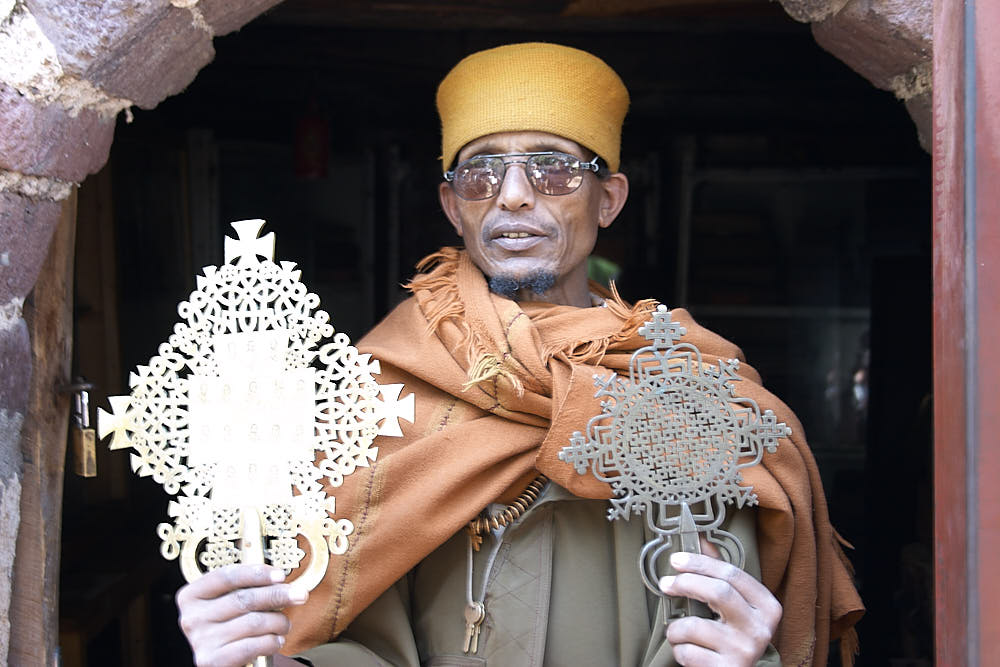
Day Four: January 16th – Bahar Dar/Gondar
This morning we slept in and got some catch up sleep after the trip from London and the excursions of the previous day. We got up at 09:00 and got something to eat. During the course of breakfast Kevin spotted the fish eagle flying over the hotel heading in to the trees nearby. So after breakfast the team headed down to the waterfront and started to look for this magnificent bird. We located him soaring him on the thermals surrounding the lake – too high to get a clear picture.
Patience was one things that we are good at so, we sat down and waiting for the bird to come to us. The eagle finally landed on some rocks out on the lake that were closer to us than the soaring heights of the bird from earlier. We got some nice pictures of the bird and determined that she was rebuilding the next in preparation of nesting there soon with a brood of chicks. We transferred to the airport and checked in for our 20 minute flight to Gondar. The flight was originally set for 08:30 but was delayed till 13:30. We found that it was necessary to confirm all flights 24 hours before departure. Again there was a local 10 bir tax per head per person for flying and that was all. We waited in the restaurant for the plane to land. It was a Fokker 50 airplane and we saw it coming in with questions from Addis. The plane dropped its guests off, refuelled and took us to Gondar.
Gonder was the 17th Century capital of Ethiopia and is notable for its medieval castles and churches. The City’s unique imperial compound contains a number of castles built between 1632 and 1855 by the various emperors who reigned during this period. These dramatic castles, unlike others in Africa, display a richness in architecture that reveals the Axumite traditions as well as the influence of Arabia. Other treasures of Gonder include the 18th century palace of Ras Beit, the bath of Fasilades, the ruined palace of Kusquam, and the church of Debre Berhane Selassie with its unique murals.
We arrived at the airport and were met by our new guide, Danny. He collected us and took us to the hotel to drop off our bags and start the afternoon of sight seeing. The flights to Gondar had been delayed and therefore the morning trip scheduled for us needed to be squashed in to the afternoon with the other activities. First of all we went to see the Debre Birhan Selassie church. There are very interesting murals on the walls inside and grounds outside are surrouded by vultures!!.
Next we went to see the Imperial Compound, with the enchanting ‘Fasalidas’ castles. The main castle was built in the late 1630s and early 1640s on the orders of Fasilidas. The Emperor, who was greatly interested in architecture was also responsible for seven churches, a number of bridges, and a three-storey stone pavilion next to a large, sunken bathing place, rectangular in shape, which is still filled during the Timkat season with water from the nearby Qaha river. This was the next stop on our flying tour for today.
Flanked by twin mountain streams at an altitude of more than 2,300 meters Gondar commands spectacular views over farmlands to the gleaming waters of Lake Tana thirty-five kilometers to the south. Our hotel is set is on a hill with a panoramic view of the town and its monuments. Stay over night at the Goha Hotel.
Day Five: January 17th – Gondar/Lalibela
We had an early start this morning as the flight was at 08:30. We got to the airport around 07:00 and checked in our bags. After paying the 10 bir per head travelling charge we looked around some of the shops and did some internet at the airport before boarding the plane. The plane arrived on time and refuelled before starting on the journey to Lalibela. At the end of the 12th and beginning of the 13th centuries, King Lalibela of the Zaghwe dynasty built a series of rock hewn churches, rightly acknowledged as one of the wonders of the world. We were collected from the airport by a local tour guide. He transferred us to the hotel for around 09:30 and we checked in to the room. There is a shortage of water in Lalibela so the running water in the hotel was switched off from 10:00 in the morning to 18:00 in the evening. We rested at the Roha hotel and awaited instructions from our guide. The instructions were a long time in coming.
We decided to take a walk down the road outside towards town and have a look in some of the shops and see what the locals were selling. We came back to the hotel and got some food in the restaurant for lunch. The hotel also sported a camp site outside and this was full due to the timkat festival about to start on the eve of the following day. After lunch we toured 8 of the 11 rock hewn churches. The first 7 were on the north side of town. Upon entering a church, the tourist was asked to remove his or her footwear as a mark of respect. Some guide books made reference to the cleanness of the carpets on the floors in these churches so as a mark of caution it was advised to wear at least one if not two pairs of socks for the durations of the church viewing.
The most famous of the churches was St. Georges – the last church that we saw for the day. Our flight for the following day was scheduled for the afternoon at 14:30. The travel agents notified us that the flight time had changed and it was now departing at 08:30 and check-in was at 07:00. This evening we looked around some more shops and purchased some statues and drawings of the churches in Lalibela before retiring to bed.
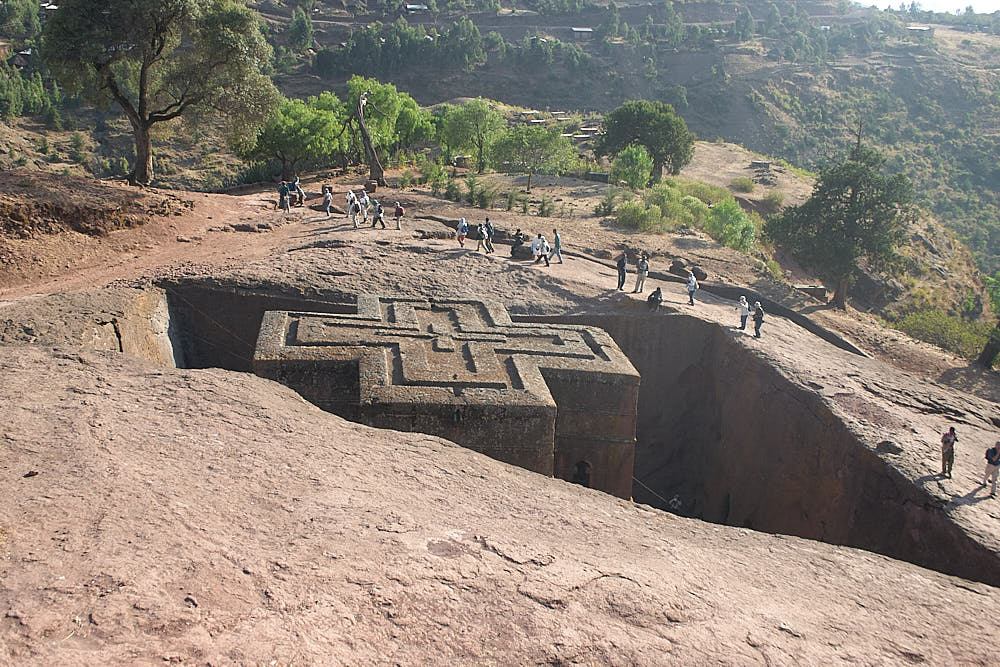
Day Six: January 18th – Lalibela/Axum
We got up at 06:00 as transfer to the airport was for 06:30. The transport was late and we arrived at the airport for 07:15. The airline attendant was not impressed with our tardiness. The flight was delayed so everything was ok. We flew to Axum – duration of 50 minutes, once one of the four great powers of the ancient world. After arriving at the airport we were met by our guide and transferred to the hotel. The guides name was See-sayid. He told us that he has worked with the archaeologists for 5 years and was working in the tourist trade for the last 3 years. We dropped our bags at the hotel and departed to see some of the sites of Axum. The hotel was really nice but the beds were really hard. We saw the remarkable stelae or obelisks, the largest single pieces of stone standing anywhere on the world. One of the stelae that was on show in Rome was due back in the country at the end of the month – January.
We also saw tombs and castles of former monarchs, the Axum Museum and the Mariamtsion Church, built on the site of Ethiopia’s first church. A chapel within the church compound is believed by Ethiopian Orthodox Christians to house the Ark of the Covenant, or the original tablets of Moses. Our tour started with a visit to the museum and the stelae. Then we ascended a hill to see the castle of King Kalab, passing Mai Shum (the bath of the Queen of Sheba) on the way. Coming back into town, we saw the tomb of King Basen, visited the small museum inside the church grounds, and at the end of the day we visited the site known as ‘Queen Sheba’s Palace’ (although it is, in fact, the villa of an Axumite notable from around the 1st century AD).
On the eve of Timkat, with great ceremony, the sacred Tabot – a replica of the Ark of Covenant that sanctifies and sits on the altar of every Ethiopian Orthodox Church inside the Holy of Holies – is taken from each church and held overhead by a priest up to the central area where the ceremony takes place. The procession started around 17:00 in the evening. The ketera (priests), debteras (deacons) and the entire congregation remove the tabot (symbolising the Ark of the Covenant containing the Ten Commandments) from each church, and take it on a deeply atmospheric march to a pool of water or river, which is blessed for the next day’s celebration. The keteras wear splendid ceremonial robes of velvet and satin and are shaded by elaborately sequined velvet umbrellas. As they advance, they shake sistras (religious bells) and swing bronze censers from which great wisps of incense smoke escape into the air. The Tabot, carried on the head of one of the priests, is cloaked in layers of rich cloth to protect it from the gaze of the impious. We stayed this night in the Remhay Hotel Axum.
Day Seven: January 19th Axum/Timkat
We got up at 07:00 and got breakfast. We were collected from the hotel and transferred to the baths where the water was to be blessed for Timkat – the celebration of the Ethiopian Epiphany. Timkat is a three-day affair. During these colorful occasions, priests are bedecked in dazzling brocade robes, carry ornate hand crosses, and move under decorated umbrellas. They chant to the accompaniment of solemn drums and rhythmic clink of sistrums. Tabots are then carried back to their place on the second day that is January 19 except St Michael church “Tabot” which is on the third day January 20. We watched the priests bless the water and the local people swarm in and gather it to bless themselves. We observed the locals baptise themselves and others with the holy water and then follow the procession back into town and the resting place of the Ark.
The afternoon was spent looking for souvenirs of the Ark. There were plenty of shops open and willing to do business with us. Findind a replica of the Ark of the Covenant proved a little harder that we thought though as there was nothing there that looked like that Ark from the Indiana Jones movie!!. Eventaully after much walking and window shopping suitalbe souveniers were purchased for the return journey with us. We stayed in the Remhay Hotel Axum again this night. They have the best pancakes on offer anywhere in Ethiopia.
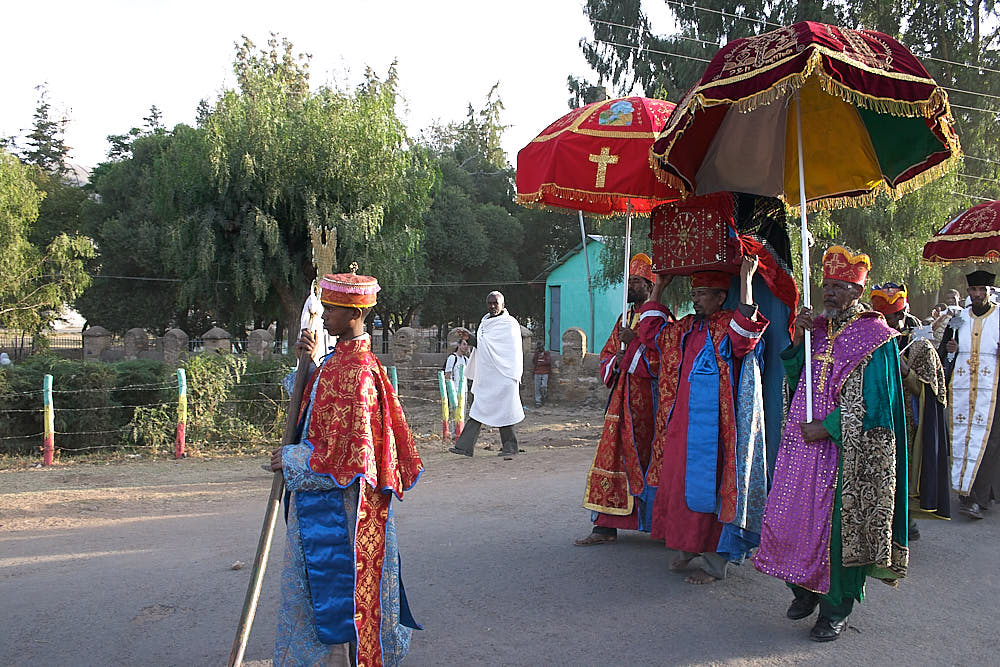
Day Eight: January 20th – Axum/Simean Highlands
We got up at 06:30 and got something to eat and then started the long drive to the Semien highlands. The distance was not that great – 240 km to De Bark and another 36km to the camp site for the night. The roads however were not up to scratch and so the drive was a long and slow process. We stopped in a place called the Shire around 9 that morning to get something to drink and break the journey. After getting a rest there were proceeded on to the next stop and town – around noon. We stretched our legs here and got a little rest. The place was busy with some other tourists but it was mostly locals that crowded the streets. Then we drove through Tekeze and the beautiful scenery of the Semien Mountains. We came upon a bus that nearly went off the road later on this day. The gravel of the road provided poor traction for the tyres on the steep descent and nearly proved fatal for the travellers in the bus. Luckily no one was hurt but it was an eye opener to anyone on how easily the accident could have happened.
We proceeded on to De Bark – the town outside of the national park from where the guides are hired for the hiking experience. The area in around De Bark was very rich and fertile and the land was greener and more scenic. We collected a guide from De Bark as well as an armed escort. This was a requirement upon entering the park. In case of an animal attack, a group of hikers must have an armed guard in their procession for safety reasons. We spent an hour getting food and supplies before heading in to the park. We entered the park around 16:30 and arrived at the camp around 18:00. It was just starting to get dark so we pitched the tents and got out our fleeces as the altitude was over 3,100 metres above sea level. We went on a short walk around the local area and got our bearing before returning to the camp fire for the night. We got some soup and pasta for dinner – eaten beside the campfire. After dinner we retired to the tents and got some sleep as we were scheduled to be up early the following morning to go on a 5 hour walk.
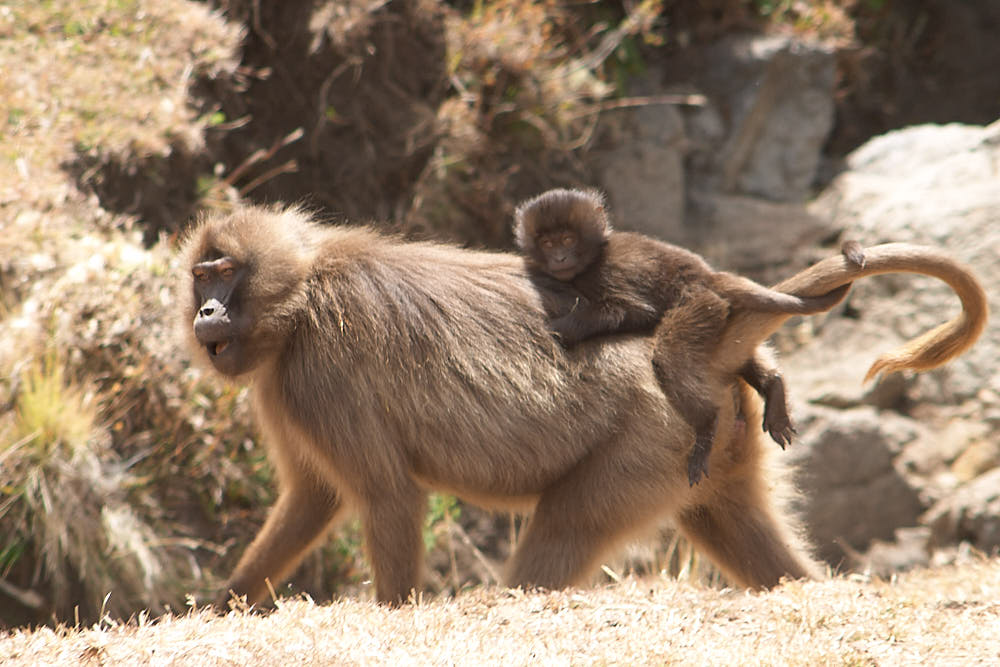
Day Nine: January 21st – Simean Highlands/Gondar
We got up around 06:30 and looked around the camp. It was early but there was some activity around the place. The cook was already busy working on getting food ready for some of the early hikers. We got some omelettes for breakfast and then got our gear together and started to head out on the hike. The first bit of wildlife that we saw was three francallin. They were by the road side and escaped in to the bush. We could hear them calling to each other for the rest of the day but they are a bird that is very hard to view. They grey/brown colour fades into the local landscape very well and acts as a superb camouflage. We walked along the rim of the valley and saw some spectacular scenery below us. Spotted some more wildlife as well in the form of the fox kestrel, the lammergeyer buzzard, the white capped plover, and the bushbuck antelope.
In around noon we happened upon some Gelada Baboons foraging for food in the midday heat. We departed the park and left for Gondar in the afternoon and got back around 16:30. There was a problem with the hotel and bookings so we spent the night in the Guara hotel inside in the centre of town. The trekking in the mountains had left us with some sub burn as we forgot to put sun screen on us when we went out walking that morning. It was a big mistake and something that we will know better of in the future.
Day Ten: January 22nd – Gondar/Addis Abiba
We were not leaving till 15:10 so we transferred to the airport at 11:00 as that was the check out time from the hotel. We rested at the airport and awaited the check in desk to open. We flew to Addis. There was a cultural show to see for some of the members of the team here. Kevin went to bed early to get a good nights sleep as we were up early to get a transfer to the airport and go home.
Day Eleven: January 23 – Departure/Arrival
Collected at 03:30 and transferred to the airport. We paid the exit tax of 20 dollars in bir to get rid of some of the last money that we had. The bank at the airport was not open at this hour of the morning so we could not change the local money that we had back to USD. The duty free would not accept the local money either so we had to spend it in some of the shops in the airport that would accept bir.
